|
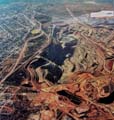
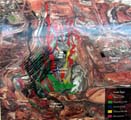
The Kalgoorlie goldfields lie in a greenstone belt,
consisting of volcanic and sedimentary rocks, all belonging
to the Archaean period of the Earth's history, aged between
2.9 and 2.6 billion years.
Golden Mile mineralisation is characterised by a very complex
pattern of closely spaced faulting.
There are over 800 ore lodes within the Golden Mile Dolerite
over an area 5km in strike and 2 km in width, and to a depth
of over 1 km.
Individual lodes may be up to 1'800 metres long, 1'200 metres
in vertical extent and 10 metres wide.
Highest gold grades are typically associated with gold-silver mercury tellurides
and alteration minerals with high vanadium contents.
|
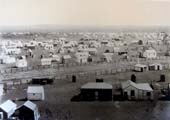
Miner's huts encircled the mines
of the Golden Mile in the early years.
|
In June 1893 three Irishmen, Paddy Hannan, Tom
Flanagan and Dan Shea, on their way to a 'strike'
at Mt. Youle, stumbled upon gold immediately west
of Mt Charlotte. Though they soon found in excess
of 100 ounces they still had no inkling that the
'richest mile on earth'- the Golden Mile - lay some
3.1 miles (5 kilometres) to the south.
This was found soon afterward by Sam Pearce and
Will Brookman, who pegged the ground that went on to
become two of the most profitable mines of all times
- the Great Boulder and the Ivanhoe.
The Great Boulder commenced operation with 30'000
pounds capital - and in the first year returned its
shareholders three times that sum!
In the following year the return doubled,
and the year after it added another 100'000
pounds, proving to be a veritable Eldorado
for its backers.
Just down the road, the Lake View Console Mine
averaged 10 ounces of gold to the ton in 1898 - current
mines make do with not much more than 10% of that!
Little wonder this was 'The Golden Mile'.
|
|
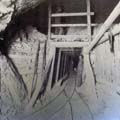
A "frame-set" in the Golden Mine.
|
Nothing lasts forever, and between 1910 and 1920
many mines amalgamated, ore recovery rates reduced
and jobs melted away. Many diggers left to fight
the Great War and the population shrank.
In 1920 the pendulum swung back the other way,
with gold prices soaring.
This recovery was short-lived and when the Depression
hit the Mile was already struggling.
It was only when the Australian Government devalued
the pound by 25% in 1931 that gold returned to profitability
- and wealth returned to the Golden Mile.
As underground mining technology improved through
the 1930s the need for labour decreased, and in 1939
large numbers of miners went off to enlist, exacerbating
a plunge in production.
|
|
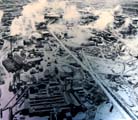
The Golden Mile from the air,
1946.
|
Recovery was slow after World War II, until the
British Government devalued the pound in 1949, lifting
the gold price by almost 50%.
Finally, in 1954 the Menzies government introduced
a gold 'bounty' which was effectively a bonus for
production in excess of the average annual production,
and at last some stability returned to the Mile.
This was the origin of the Super Pit, Kalgoorlie-Boulder's
famous landmark that will eventually stretch 3.8km
long, 1.35 km wide and go down to a depth of more
than 500 metres.
What had once been the Golden Mile, was named
the Fimiston Open Pit, which in turn has become commonly
known as the Super Pit.
Where small operations had once controlled the
famous Golden Mile, Western Australia businessman
Alan Bond started buying up the individual leases
during the 1980s, seeking to create one big company
and one big pit, from which gold could be extracted
with massive equipment at a much reduced cost.
|
|
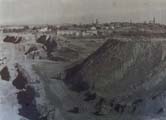
Smaller pits such as Great
Boulder, seen here in 1984,
were swallowed up by the
Super Pit.
|
Ore recovery rates had fallen so low, and underground
mining had become so expensive that 'open cut' mining
appeared the only way forward.
Significant changes - the most since gold was
first discovered in Kalgoorlie by Paddy Hannan in
1893 - occurred.
It was now possible to mine far more economically
- and to continue the harvest of the Golden Mile,
which has produced nearly 50 million ounces of gold
since the days of Paddy Hannan and his fortuitous
Golden Quest.
Others who had embarked on quests of their own,
including Bayley and Ford, Leslie Robert Menzies
and young John Aspinall would doubtless be amazed
at what their adventures have led to.
|
|
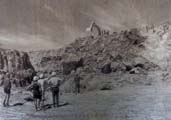
A substantial wall collapse in
the Horseshoe Pit on February 8,
1984, illustrates the lessons of
early big pit mining.
|
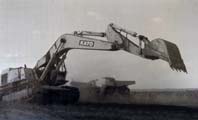
The start of true BIG pit trial mining,
on the top of what was known as
Associated Hill, 28/8/1987.
|
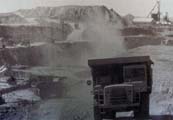
Work on the Horseshoe Pit
commenced in 1989 - it is now
330 metres deep!
|
The fleet of machines they use is pretty impressive in all
aspects, not just its size ....
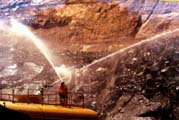
|
One of the visual impacts of the mining activity is
the dust generated by open pits blasting.
To protect the community from blasting dust, the
mine operates according to a Dust Monitoring and Management
Programme, essentially involving avoiding surface blasting
during unfavourable weather conditions based on forecasts
from the Bureau of Meteorology and measured wind data.
Surface blasts may occur:
• If the wind is blowing blasting dust away
from residential areas;
• If it is raining;
• If the explosives must be detonated due to
safety reasons.

|
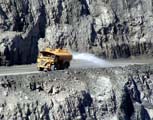
|
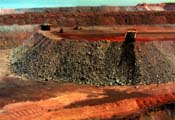
|
Waste rock doesn't contain gold or has gold in such
low concentrations that it can't be economically processed.
Waste rock from open pit mining is trucked to and stacked
in areas referred to as waste rock dumps.
Regular reviews and optimisation of dumping plans and
trucking routes occurs to keep the dumps at short distances
from the open pit.
The waste rock dumps are a significant feature of the
landscape and are very visible.
The best design is one that will have characteristics
of other landforms in the region. |
|
|